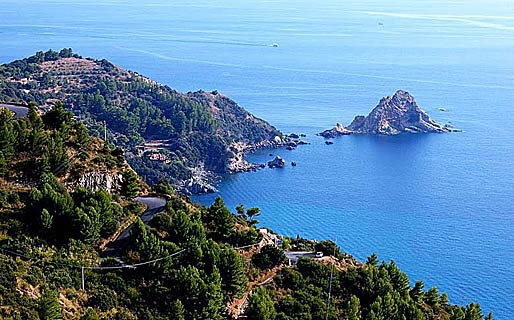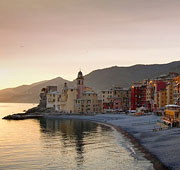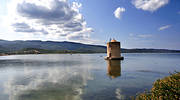Tuscany's "Almost Island"
Monte Argentario, the Island that Isn't
My doctor can hold his breath for a very long time.
I know this because once we were making small talk, as one does with one's doctor, and hobbies came up. He mentioned that he was a freediver, which, I learned, is a type of diving without using scuba gear. He told me he could hold his breath for almost four minutes.
Four minutes is a long time. Try it.
But that's not what struck me the most about this conversation. What struck me the most was this: I asked him where he dives, and he told me most often at Monte Argentario. This was twenty years ago, when I had first moved to Italy and there was much of the Bel Paese I had yet to explore.
"Wait," I said. "You dive on a mountain?"
"No," he laughed. "Monte Argentario isn't a mountain. It's an almost island."
Little did I know, all those years ago, that Monte Argentario would come to be a beloved holiday destination for my family and we would spend many a happy summer on this "island that isn't".
As it turns out, Monte Argentario once really was an island. This land mass off the coast of Tuscany near the true islands of Giglio and Giannutri (the southernmost of the Tuscan isles) was detached from the mainland for millenia until a change of sea current and the silt of the nearby Albegna River formed two thin stretches of sand (tomboli in Italian), joining it precariously to the coast.
A third finger of land formed by a dyke from the town of Orbetello joined the promontory to the mainland in 1842 and the two lagoons formed by these three geographic threads between Maremma coast and almost island are WWF wildlife refuges, where migrating birds from across Europe stop along their route toward warmer climes each fall.
Monte Argentario really is a haven for divers...but also for those who simply love the craggy, dramatic coast (often reminiscent of Sardinia), marked by coves, caves, and grottoes. Above this, the jagged slopes rise steeply, covered in lush Mediterranean scrub, pine and oak woods, vineyards, and olive groves. In the center of the island, Mount Telegrafo rises above the surrounding countryside, and along the coast the resort towns of of Porto Santo Stefano and Porto Ercole bustle with a festive holiday air.
Because of its rather tortuous history, during which it was ruled by both Spain and Naples, the vibe on the island is much different than the rest of Tuscany and at times it almost seems more similar to southern Italy than to the decidedly more reserved center regions.
Though it's truly an "almost island", Monte Argentario has all the atmosphere and beauty of an Italian island while being close enough to the coast to be easily accessible by car. Here are some of the island's highlights:
Towns
Porto Santo Stefano is the largest town on Monte Argentario, dominated by the imposing 16th centuryFortezza Spagnola, but was unfortunately heavily bombed during World War II. Rebuilt in the decades after the war, the result is a modern yet still lovely port with pastel houses climbing from the harbor up the hillside. Here there is both a charming old port and a fashionable modern marina, and the town is bustling in high season with vacationers visiting the local shops, restaurants, and fish markets.
Ferries for the nearby islands of Giglio and Giannutri leave from here, and there's both an acquarium and an archaeological museum in the Fortezza worth visiting.
Smaller Porto Ercole sustained much less damage during the war, and has retained much of its lovely historic center. More picturesque than Porto Santo Stefano, this bay creates a natural harbor lined with fishermen's houses, cafès, and restaurants, and there are both and and pebble beaches along the coast.
Here the inhabitants are decendents of Neapolitan fishermen, and there is a distinctly southern Italian feel to the town. Stop in to visit the Chiesa di Sant Erasmo in the historic center and the four Spanish fortresses, in particular Forte Stella, which look down on the town from above.
Beaches
The two natural sand bars that join Monte Argentario to the Tuscan coast are both de facto long stretches of beach. Giannella to the north is lined with stabilimenti, or bathing establishments with umbrellas and loungers for rent, refreshment stands, and sports facilities. This is the perfect stop for families. To the south, Feniglia is a 6 kilometers stretch of sand and pine trees closed to traffic. Perfect for bikers or bathers who are less attracted to bathing establishments and more to nature, as much of the stretch is part of a nature reserve.
On Monte Argentario, there are a number of small, remote coves lined with sand or pebble beaches that are best reached by boat as the footpaths can be steep and treacherous. Cala del Gesso, Argentarola, and Cala Piccola are all lovely spots (the latter two accessible only to those who are guests at neaby hotels or villas), and Cala Grande (accessible only by sea), Spiaggia Lunga, Acqua Dolce, and Cala Piazzoni are also popular beaches.
Nature
Monte Argentario can get crowded in the high summer season, but the vast majority of visitors are concentrated on the coast: the beaches and port towns are hopping with daytrippers and vacationers. To escape the crowds, take one of the many hiking trails that wind their way inland with sweeping views over the lush countryside and Mediterranean. For the truly ambitious, the 18 kilometer route between Porto Ercolea and Porto Santo Stefano is truly spectacular, and if you hike up the slopes to the 635 meter peak of Mount Telegrafo you are rewarded with a view of the Tuscan arcipelago and Corsica.
Another wonderful way to get away from the holiday crush is to head to the nature reserve on the Tombolo della Feniglia, the southernmost stretch of sand between the promontory and the coast. Here the lagoon that was formed by the gradual buildup of the silt fingers connecting the two coasts is home to a number of waterfowl and migratory birds and wild animals, including deer and wild boar.
Of course, we there is also Monte Argentario's fabulous diving (and with this we have come full circle). Here, you can explore the rocky shores and sea caves with mask and flippers, or, if you are certified, take guided dives with one of the local diving outfitters and centers. Explore the coral reefs and shipwrecks for colorful fish, sponges, eel, octopus, and other marine animals.




















